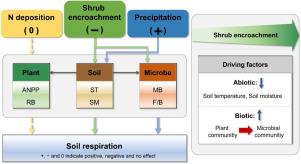Agricultural and Forest Meteorology ( IF 6.2 ) Pub Date : 2022-09-08 , DOI: 10.1016/j.agrformet.2022.109155 Xiaojing Yang , Guanhai Xiang , Weicheng Sun , Yonggang Chi , Wenhuai Li , Yongfei Bai , Zhengchao Zhou , Shuxia Zheng

|
In the context of global change, changes in precipitation patterns and increases in atmospheric nitrogen (N) deposition have important impacts on grassland ecosystem processes and functions, such as soil respiration. However, most studies on the effects of increased precipitation and N enrichment on soil respiration have focused on pure grassland vegetation types (such as typical steppe), but less on grassland at different stages of shrub encroachment. Here, we examined the effects of increased precipitation and N enrichment on soil respiration and its components (heterotrophic and autotrophic respiration) in different stages of shrub-encroached steppe (i.e., no shrub invasion, light, moderate and severe encroachment) based on water and N addition experiments. Our results showed that increased precipitation greatly promoted soil respiration in typical steppe, lightly and moderately shrub-encroached steppe, but had no significant effects in severely encroached steppe; particularly, soil respiration in a wet year (2021) was significantly higher than that in a dry year (2020). However, N addition had no significant effect on soil respiration across the four stages of shrub encroachment, mainly due to the severe soil water limitation. In general, shrub encroachment significantly reduced soil respiration in Inner Mongolia steppe, mainly by increasing soil temperature, but decreasing soil moisture, microbial biomass and root biomass. We found that the driving factors of soil respiration varied with the development of shrub encroachment, especially the biological factors gradually shifted from aboveground plant community to underground microbial community. These findings have important implications for assessing carbon emissions from arid and semi-arid grasslands under global change. Considering that the effects of increased precipitation and N deposition on shrub-encroached steppe (especially severely encroached steppe) were different from those of typical steppe, the stage of shrub encroachment should be fully considered when constructing carbon cycle models to accurately evaluate the carbon emissions of degraded grassland.
中文翻译:

灌木侵占驱动土壤呼吸对降水增加和氮富集的不同响应
在全球变化的背景下,降水模式的变化和大气氮(N)沉降的增加对草地生态系统过程和功能(例如土壤呼吸)具有重要影响。然而,关于降水增加和N富集对土壤呼吸影响的研究大多集中在纯草地植被类型(如典型草原)上,而对灌木侵占不同阶段草地的研究较少。在这里,我们研究了降水增加和氮富集对土壤呼吸及其成分(异养和自养呼吸)的影响,在灌木侵占草原的不同阶段(即无灌木侵占,轻度、中度和重度侵占),基于水和N个加法实验。结果表明:降水增加对典型草原、轻度和中度灌侵草原土壤呼吸有显着促进作用,而在重度侵占草原则没有显着影响;特别是,雨年(2021年)的土壤呼吸显着高于旱年(2020年)。然而,N添加对灌木侵占四个阶段的土壤呼吸没有显着影响,这主要是由于严重的土壤水分限制。总的来说,灌木侵占显着降低了内蒙古草原的土壤呼吸,主要是通过提高土壤温度,但降低土壤水分、微生物量和根系生物量。我们发现土壤呼吸的驱动因素随着灌木侵占的发展而变化,特别是生物因子逐渐从地上植物群落转向地下微生物群落。这些发现对于评估全球变化下干旱和半干旱草原的碳排放具有重要意义。考虑到降水增加和氮沉降对灌侵草原(尤其是严重侵占草原)的影响与典型草原不同,在构建碳循环模型时应充分考虑灌木侵占的阶段,准确评价草原的碳排放。退化的草地。


























 京公网安备 11010802027423号
京公网安备 11010802027423号